12. Graph Algorithms
Now we have the tools to see some graph algorithms.
12.1. Topological Sort
A topological sort is an ordering of nodes in a directed acyclic graph.
If there is a path from \(v_i\) to \(v_j\).
Then \(v_j\) appears after \(v_i\) in the ordering.
Example
Following an acyclic graph.
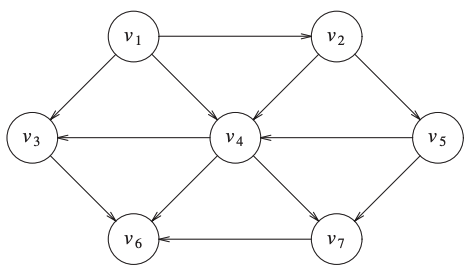
An example of a topological ordering: \(v_1, v_2, v_5, v_4, v_7, v_3, v_6\).
Activity
Give another topological ordering.
12.1.1. A Simple Algorithm
We define the indegree of a node \(v\), as the number of edges \((u,v)\).
A simple algorithm to find topological ordering is:
Find any vertex with an indegree of 0.
Remove it along with its edges.
Apply the strategy with another vertex.
We obtain the following pseudocode:
1void topsort()
2{
3 for (int counter = 0; counter < NUM_VERTICES; counter++){
4 Vertex v = findNewVertexOfIndegreeZero();
5 if (v == NOT_A_VERTEX){
6 throw CycleFoundException();
7 }
8 v.topNum = counter;
9 for each Vertex w adjacent to v{
10 w.indegree--;
11 }
12 }
13}
Where
findNewVertexOfIndegreeZero()scans the array of vertices looking for a vertex with indegree 0.If it returns
NOT_A_VERTEXit indicates that the graph has a cycle.The complexity of this algorithm \(O(|V|^2)\).
12.1.2. A Second Algorithm
The graph could be parsed, so checking each vertex could be a waste of time.
A second way to make a topological sort is to place every vertex of indegree 0 in a queue.
While the queue is not empty we remove one vertex.
All the adjacent vertices have their indegree decremented.
Following a pseudo-code of the algorithm:
1void topsort()
2{
3 Queue<Vertex> q;
4 int counter = 0;
5
6 q.makeEmpty( );
7 for each Vertex v
8 if( v.indegree == 0 )
9 q.enqueue( v );
10
11 while( !q.isEmpty( ) )
12 {
13 Vertex v = q.dequeue( );
14 v.topNum = ++counter; // Assign next number
15 for each Vertex w adjacent to v
16 if( --w.indegree == 0 )
17 q.enqueue( w );
18 }
19
20 if( counter != NUM_VERTICES )
21 throw CycleFoundException();
22}
The running time of this algorithm is \(O(|E|+|V|)\).
Activity
Can you explain the running time?
Apply this algorithm to the previous graph.
12.2. Shortest-Path Algorithms
There are different shortest-path algorithms.
But, they have common properties:
The input is a weighted graph.
The weight for each edge \((v_i, v_j)\) is a cost \(c_{i,j}\) to traverse the edge.
The cost of a path \(v_1v_2\dots v_N\) is \(\sum_{i=1}^{N-1}c_{i,i+1}\).
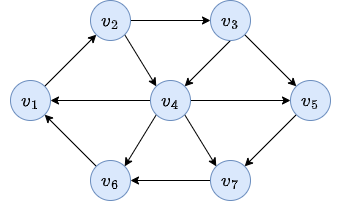
Activity
What would be the cost of the path in an unweighted graph?
Consider the previous graph:
What is the cost of the path \(v_1, v_2, v_5, v_7\).
Do you have a shorter path from \(v_1\) to \(v_7\)?
12.2.1. Breadth-First Search
Finding the shortest path in an unweighted graph is considering a weighted graph where all the edges have a cost of 1.
It is minimizing the number of edges in the path.
We will introduce a single source shortest-path algorithm for unweighted graph \(G = (V, E)\).
Single source means that we calculate the shortest path from a specific node \(s \in V\) to any other nodes \(v_k \in V\).
A very simple algorithm is breadth-first search.
The idea is to process nodes in layers.
Example
Consider the previous unweighted directed graph.
We want to apply breadth first to find the shortest path from \(v_1\) to \(v_6\).
We obtain the following steps:
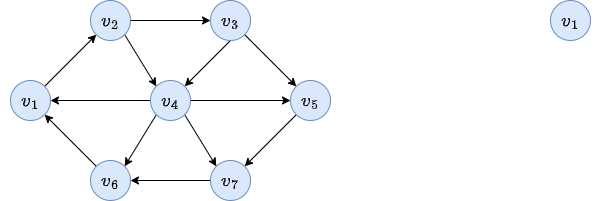
We start with the first node \(v_1\).
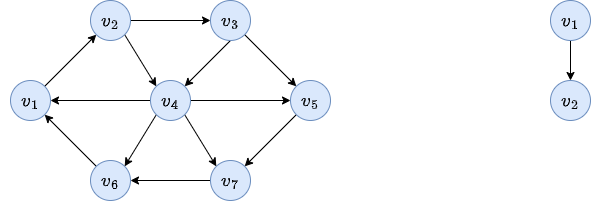
We check each arc leaving \(v_2\).

We check each arc leaving \(v_4\).
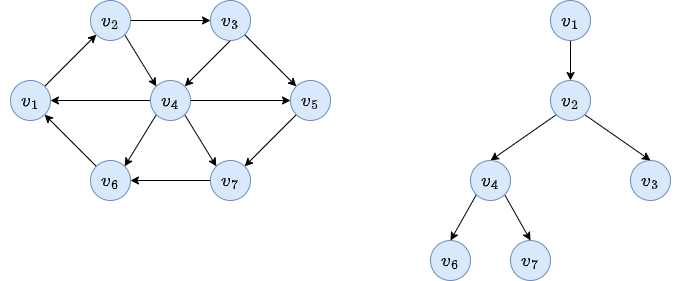
Finally, the arcs leaving \(v_3\).
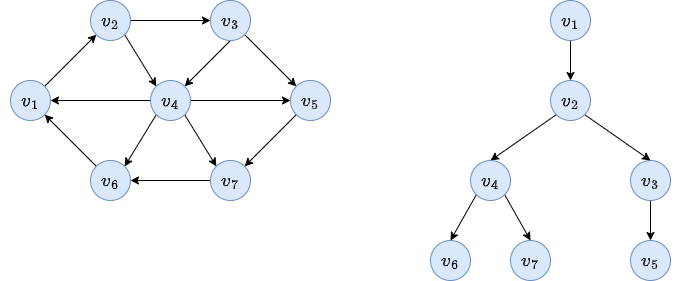
Activity
Apply the algorithm to find the shortest path from \(v_4\) to \(v_1\).
12.2.1.1. Implementation
First we create a table that will keep track of the algorithm progress.
The table will keep track for each node it was visited or marked.
The pseudo-code is given below:
function BFS(Graph, source):
Create a queue Q.
Q.insert(s).
while Q not empty:
u = Q.pop()
visit(u)
for all v adjacent to u:
if v not marked or visited:
Mark v
Q.insert(v)
The complexity of this algorithm is \(O(|V|^2)\).
Activity
Is the algorithm efficient?
If not, how would you improve it?